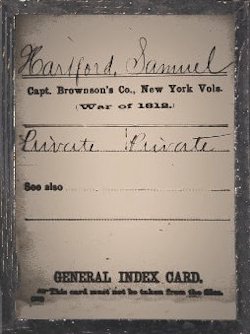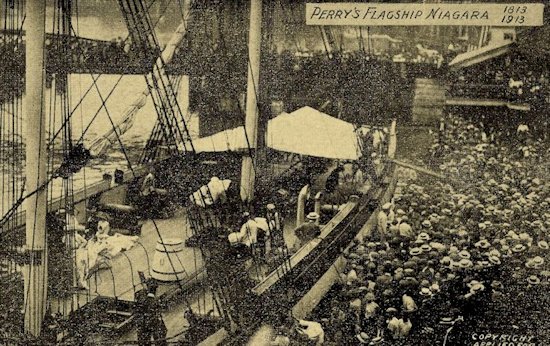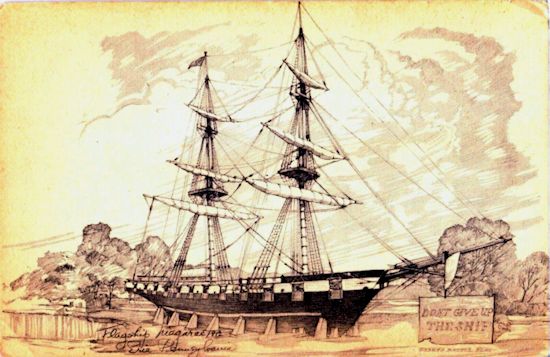Surnames: HARTFORD, WALL
----Source: LOYAL CENTENNIAL BOOK (Loyal, Clark County, Wis.) - 1970, Federal Census, Family Notes, The Wisconsin Magazine of History, July 1926, Volume IX, #4
Hartford, Samuel, 25 Feb 1798 - 1 Aug 1884
(Plaque in Pine Grove, Clark County, Wis. Cemetery says the following) When a lad of fourteen Samuel Hartford went as a substitute for his brother-in-law, that his sister and her seven little ones might not be deprived of a husband and father's care -- served as a private in the New York Militia -served the War of 1812 at the Battle of Niagara, (Formerly known as The Battle of Lundy's Lane) honorably discharged Sept. 30, 1813.
|
Dedication of the Samuel Hartford Plaque
October 4,
1925, an unusual memorial was dedicated at Pine Grove
Cemetery, Loyal, Clark County, to the memory of "Samuel Hartford
(1798-1884), soldier of the War of 1812, when a lad of fourteen went
as a substitute for his brother-in-law that his sister and her seven
little
ones might not be deprived of a husband and father's care—served as
a private in New York Militia—was in Battle of Niagara—honorably
discharged, Sept. 30, 1813." The dedication address was made by
Judge
James O'Neill of Neillsville, and the memorial was accepted by Miss
Sophia Hartford, granddaughter of the veteran soldier. The tablet
made of solid copped is fastened on a large pine tree at the foot of
the
family lot. An attractive booklet has been prepared, compiled by
Mrs.
A. K. Church, to whose unwearied efforts the securing of the
memorial
is due. This book contains in addition to a description of the
memorial
exercises an account of the settlement of Loyal in 1864 and sketches
of
the pioneer founders.
|
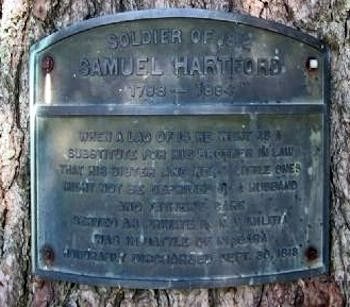
|
Grave Marker for Samuel Hartford Served as private -N. Y. Militia in Battle of Niagara Inscription: When a lad of 14 he went as a substitute for his brother in law that his sister and her 7 little ones might not be deprived of a husband and father’s care. Photographed By Keith L, July 14, 2008
|
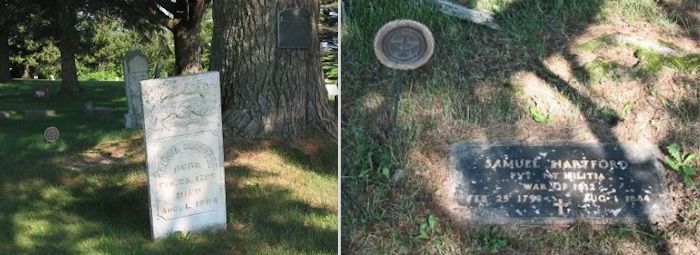
The Battle of Niagara in the War of 1812--Also known as The Battle of Lundy's Lane
The peacefulness and civility of the newly developed region, would be put aside
from 1812 to 1814 when the Niagara region became the battleground of some of the
bloodiest battles in Canadian history. On June 18, 1812 the US declared war
against Great Britain, and by extension Canada, in their desire for supremacy of
the land. They believed they could capture and claim the British territory of
Canada relatively easily, and they began attacking the country on three fronts
via Lake Champlain, the Niagara Frontier, and Detroit.
On October 13, 1812 war came to the Niagara region when American troops crossed
the Niagara River from Fort Niagara in the hopes of capturing the town of
Queenston. The American troops landed their boats in the early hours of the
morning hoping to catch the British soldiers by surprise.
Although they greatly outnumbered British troops, who had an army of only 500
soldiers and 800 militia, the Americans were met with much resistance and were
unable to defeat the British troops. Led by one of the greatest Canadian
Generals, General Brock, the British troops had taken position in the Redan
battery, an artillery station, which had the vantage point of being on top of a
hill.
When American troops landed on the shores of Queenston Heights, the British
began firing upon them and a number of men were killed or wounded as they
attempted to charge up the hill. With many losses the Americans retreated and
regrouped. The Americans were able to alter their initial plan when they found
an unguarded fisherman’s path that led up the hill, and they charged up the hill
undetected, taking the British by surprise. The British troops were able to
abandon the battery and retreat into the village, however, Brock would return to
Queenston Heights with his troops in an attempt to reclaim it from the
Americans. During this attempt Brock was killed and his troops were driven back
by the Americans once again. With the help of Indian troops, who held
allegiances with the British, they were able too regain the Redan after only
half an hour of battle. The Americans lost 1,200 of their men, who were either
wounded or killed and the troops that were still alive on the hill were taken
prisoners. Although Brock died during the Battle of Queenston Heights his ideas
were much respected by the troops and his strategies were carried on during the
first two years of the war.
A few weeks later in the early hours of the morning of November 28th, 1812, 400
American troops travelled across the Niagara River from Black Creek, in an
attempt to capture Fort Erie. A group of Americans had been ordered to seize the
guns at Fort Erie and did so successfully despite British resistance. In the
meantime a second group of Americans set out to destroy Frenchman’s Creek
bridge, in an effort to delay British reinforcements coming from Chippawa. The
British army was soon able to take control of the area and they forced the
Americans to retreat back to Black Creek.
The Americans made much ground during the spring and summer of 1813. On April
27th, 1813 American troops had captured and burned the city of York, which was
the capital of Upper Canada, and by May 27th they had moved onto Fort George and
easily captured it. British troops fought back, however they were greatly
outnumbered, and they were forced to retreat to the city of Hamilton. Fort
George became the headquarters for US forces. Its strategic location was put to
good use as they utilized it to invade the rest of Upper Canada. Fort George was
eventually reclaimed by the British in December of 1813 and it was occupied by
the British for the remainder of the war.
On June 24th, 1813, British forces, who were stationed at Decew Falls, received
an advanced warning of an impending US attack. United Empire Loyalist, Laura
Secord was at her homestead in Queenston when three American soldiers began
pounding on her door demanding she let them in and provide them with meals.
While they ate she over heard them speaking of an impending attack on the
British at nearby Beaverdams. Knowing that a surprise attack could mean a major
blow to the British, she walked 20 miles through wild bush and swamp to warn
them of the impending attack.
The British had a limited number of troops in the area and in order to
successfully defeat the Americans, British commander Fitzgibbons called for the
help of the Indian warriors. The Indian warriors were able to successfully
ambush and defeat American forces. The Americans had suffered heavy losses from
the brutal battle and would eventually be forced to surrender to British troops.
Laura Secord, along with the native fighters were largely responsible for this
victory as British soldiers did not fire a single shot during the battle. Laura
Secord is now considered a Canadian heroine, and legend, her homestead can still
be seen in the quaint town of Queenston, and a monument was erected in her
honour in Queenston Heights Park.
On December 10, 1813 the Americans who had been held up at Fort George decided
to retreat as conditions were worsening due to the harsh winter. On their way
back to Fort Niagara they burned the town of Newark, now Niagara-on-the-Lake. At
the time the town largely consisted of women and children, and the American
troops burned their homes to the ground, leaving them homeless and desolate in
the middle of a cold December. Every building except one was burned to the
ground and when dawn broke the next morning British troops found many dead women
and children who had frozen to death because they were unable to find shelter
from the bitter cold. The British soon retaliated by capturing Fort Niagara,
which had large stores of food, clothing, and weapons. British forces along with
their Indian compatriots began burning the surrounding towns of Youngstown,
Lewiston, Manchester, and Buffalo, capturing and killing many Americans.
On July 3rd, 1814 6,000 American troops crossed the Niagara River, and took over
Fort Erie with little resistance from the British, who had an army of just over
130 soldiers. They then began advancing north towards Chippawa. The British
hearing of the advancement began to move towards the Americans who had set up
camp at nearby Street’s Creek. As dawn broke on the 5th of July British forces
along with their Indian compatriots began advancing on the Americans. When they
reached Street’s Creek the battle began, it lasted only half an hour and ended
in an American victory. The British sustained heavy losses with 415 men either
being killed, wounded or captured, and they were forced to retreat under heavy
gun fire to Chippawa Creek.
On July 12th, 1814 American troops came upon the small village of St. David’s.
They began looting the village, killing off the livestock and taking whatever
they could carry from the homes. In a final act of revenge they set the town
ablaze, burning over 40 homes and businesses and leaving the villagers homeless.
The famous battle at Lundy’s Lane saw many casualties on both sides, and has
been called “the bloodiest battle” of the War of 1812. It was fought on July
25th, 1814, mainly during the night by 5,000 American and 2,200 British,
Canadian militia and First Nations fighters. At the beginning of the battle
British troops held their ground on the top of the high ridge that overlooked
Lundy’s’ Lane and were able to fire on the advancing Americans with little
resistance. The Americans attempted several volleys to take control of the road
but the British held fast. It was not until the Americans advanced under heavy
fire that they were able to seize the British’s cannons, and were then able to
take control of the hill and subsequently take advantage of the field.
The two sides than fought throughout the night and would fight in a vicious hand
to hand combat stabbing and shooting each other at close range in order to hold
onto their artillery. The British would make several attempts throughout the
night to retrieve the guns but were unsuccessful, tired and with many wounded
they retreated to the woods behind the hill. The Americans too were exhausted
from battle and they retreated to their Chippawa camp some 5 kilometres away.
When dawn broke the British returned to take control of the abandoned
battlefield. They were met with a massacre in their wake, they reportedly lost
over 800 men and the Americans had over 860 casualties. Hundreds of others had
been badly wounded or captured by the enemy. The battle ended in a stalemate,
with the Americans retreating to nearby Chippawa, then to Fort Erie, burning the
small town of Bridgewater along the way.
The Americans were able to travel to Fort Erie with little resistance. On
finding the Fort they immediately began to repair and expand it, enlarging it to
15 acres with three gun batteries. The British would arrive at the Fort a few
days later ready to fight once again. They planned to take control of the Fort
by attacking the batteries simultaneously. However, the Americans were well
prepared having had several days to fortify it for battle. A bloody battle would
ensue with heavy losses for the British, over 900 men had been killed, wounded,
or went missing. With the onset of heavy rain the British bunkered down for 13
days, before retreating to Chippawa. The Americans followed attempting to attack
the British on several occasions with little success. After several days the
Americans returned to the US to defend Buffalo, destroying Fort Erie in their
wake. The historical Fort was eventually fully restored in 1938 and is now open
to the public.
The bloody war saw great losses on both sides it finally concluded when the
Treaty of Ghent was signed on Christmas Eve 1814. The Niagara River was once
again established as the natural border between the two countries, who were now
at peace with one another. Neither country would emerge as the victor, however,
the war played a key role in establishing Canada as a nation. After the war the
region was in ruins, as many villages and buildings were burned to the ground,
and it took nearly a decade to fully restore the area. Tour of Niagra
1830 Federal Census, Fort Covington, Franklin, New York
Fefield Hartford [Ffield Hartford] [Fifield Hartford]
Free White Persons - Males - Under 5: 1
Free White Persons - Males - 30 thru 39: 1
Free White Persons - Females - Under 5: 1
Free White Persons - Females - 5 thru 9: 1
Free White Persons - Females - 10 thru 14: 2
Free White Persons - Females - 30 thru 39: 1
Free White Persons - Under 20: 5
Free White Persons - 20 thru 49: 2
Total Free White Persons: 7
Total - All Persons (Free White, Slaves, Free Colored): 7
1840 Census, Home in 1840 (City, County, State): Clayton, Jefferson, New York
Fifield Hartford [Tafield Hartford] [Fifield Hartford]
Free White Persons - Males - Under 5: 1
Free White Persons - Males - 10 thru 14: 1
Free White Persons - Males - 40 thru 49: 1
Free White Persons - Females - Under 5: 1
Free White Persons - Females - 5 thru 9: 1
Free White Persons - Females - 15 thru 19: 1
Free White Persons - Females - 40 thru 49: 1
Persons Employed in Agriculture: 1
Free White Persons - Under 20: 5; Free White Persons - 20 thru 49: 2
Total Free White Persons: 7
Total All Persons - Free White, Free Colored, Slaves: 7
1850 Federal Census, Herman, Dodge, Wisconsin, USA, Line #32, Dwelling #30, Family Number: 31
Samuel Hartford, White 51 yr. old male, farmer, b. VT
Industry: Agriculture, Real Estate: 1000
Spouse: Jane Hartford
Inferred Children: John Hartford; Mary Jane Hartford; Emily Hartford; Samuel
Hartford; Fifield Hartford; Moses Hartford; James Hartford
Household Members
Samuel Hartford 51
Jane Hartford 43
John Hartford 19
Mary Jane Hartford 17
Emily Hartford 13
Samuel Hartford 11
Fifield Hartford 9
Moses Hartford 6
James Hartford 3
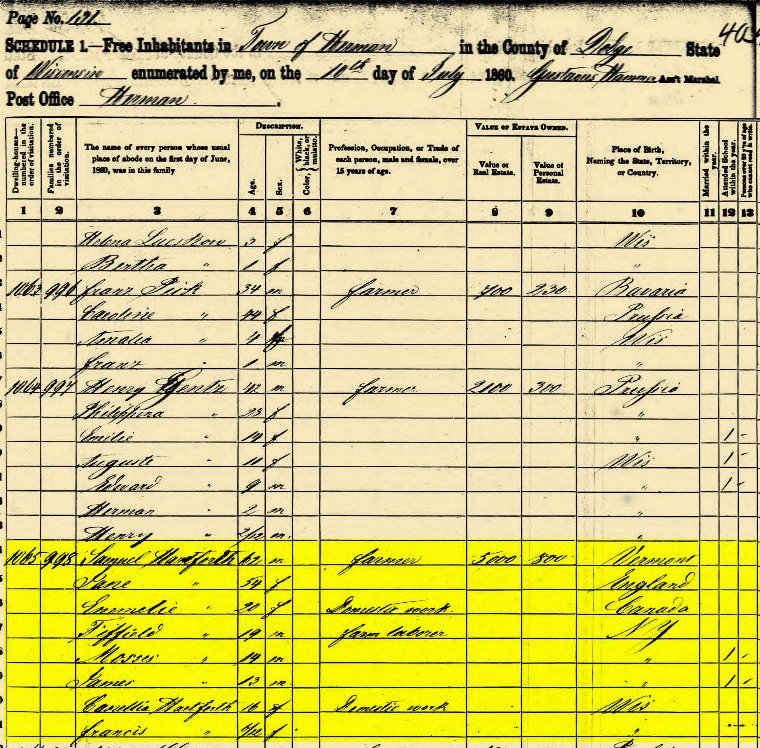
1860 Federal Census, Herman, Dodge, Wisconsin; Post Office: Heman;
Samuel Hardforth [Hartford]
Age: 62 (1798)
Gender: Male; Race: White; Birth Place: Vermont, Dwelling Number: 1065; Family #
998
Occupation: Farmer
Real Estate Value: 5000; Personal Estate Value: 800
Inferred Spouse: Jane Hardforth
Inferred Children: Emmelie Hardforth, Fiffield Hardforth, Mosses Hardforth,
James Hardforth
Household Members
Samuel Hardforth 62
Jane Hardforth 54
Emmelie Hardforth 20
Fiffield Hardforth 19
Mosses Hardforth 14
James Hardforth 13
Camellia Hartforth 16
Francis Hartforth 6/12
1870 Federal Census, Illinois, Schuyler, Littleton, Dwelling 192
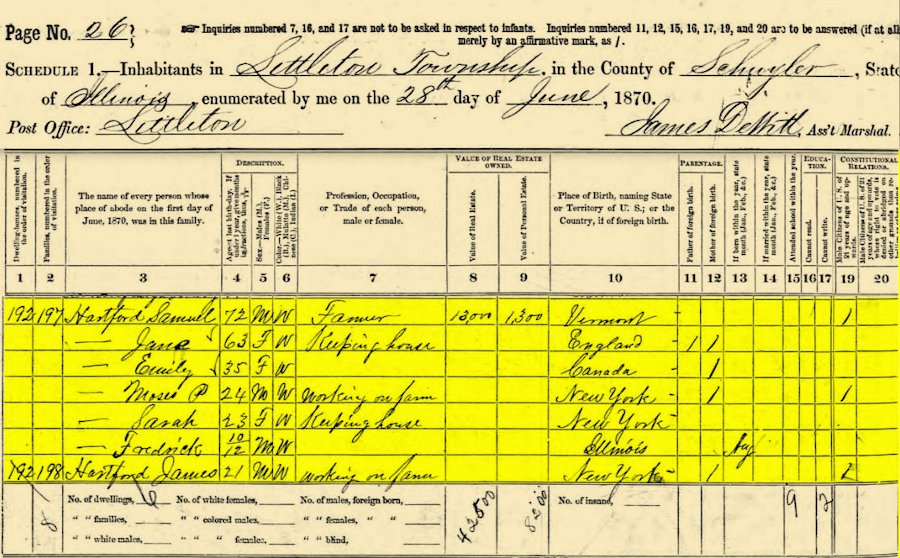
Samuel Hartford, 72 yrs., (1798), b. VT; White male, Farmer
Personal property value: 1300
Realestate value: 13000
Spouse: Jane Hartford
Children: Emily Hartford; Moses P Hartford; Sarah Hartford; Fredrick Hartford
Household Members
Samuel Hartford 72
Jane Hartford 63
Emily Hartford 35
Moses P Hartford 24
Sarah Hartford 23
Fredrick Hartford 10/12
1880 Federal Census, Algona, Kossuth, Iowa, USA, Dwelling Number: 94
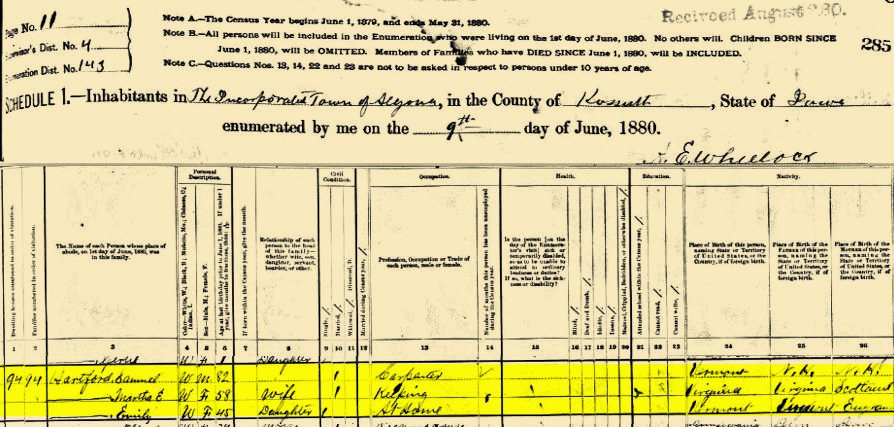
Samuel Hartford, 82 (1798), VT, White Married Male
Spouse's Name: Martha E. Hartford
Father's Birthplace: New Hampshire
Mother's Birthplace: New Hampshire
Occupation: Carpenter
Household Members
Samuel Hartford 82 Self (Head)
Martha E. Hartford 58 Wife
Emily Hartford 45 Daughter
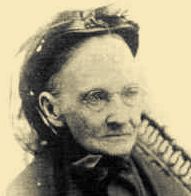
Ellen Wall Hartford
Ellen was born 30 June 1821 Logan, West Virginia, the daughter of William Wall
(1758–1835) and Nancy Elkins (1796–1829).
Ellen passed away 9 Jan 1910 Pleasant Green, Cooper, Missouri. She was first
married (20 Jul 1841 in Anderson Twp., Madison, Indiana) to Zimri Thomas
Moon (1812–1886). Their children were: Lucy Moon 1842–1842; William Moon
1843–1843; Zamira Moon 1845–1846; Zenas Evedin Moon 1847–1926; Miles Moon
1848–1848; Asa Moon 1849–1849; Sara Frances Moon 1850–1928; Zara E Moon (male)
1852–1942; Lucy Emily Moon 1855–1855; Nelly Moon 1856–1856 and Frank Moon
1857–1939.
*Spouse: #1-Mary Ellen Wall, #2 Jane, #3 Martha Evangeline Moon
**Parents: Parents: Joshua Hartford; Lucy Mead
